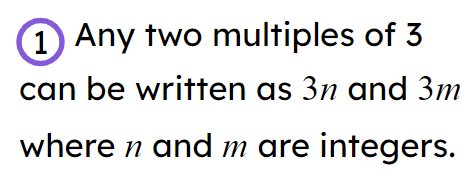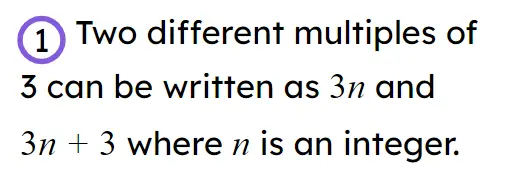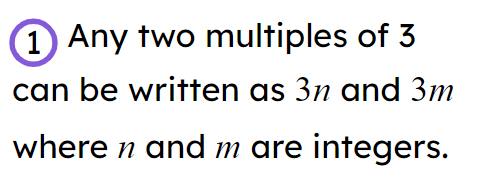Myths about teaching can hold you back


- Year 11•
- Higher
Writing a proof
I can manipulate and transform algebraic expressions in order to prove or show a result.


- Year 11•
- Higher
Writing a proof
I can manipulate and transform algebraic expressions in order to prove or show a result.
These resources will be removed by end of Summer Term 2025.
Switch to our new teaching resources now - designed by teachers and leading subject experts, and tested in classrooms.
These resources were created for remote use during the pandemic and are not designed for classroom teaching.
Lesson details
Key learning points
- Any algebraic expression must be defined so that it is clear what it represents.
- Algebraic expressions can be manipulated to create a different form that is equal.
- This manipulation can be used to prove or show a result.
Keywords
Conjecture - A conjecture is a (mathematical) statement that is thought to be true but has not been proved yet.
Generalise - To generalise is to formulate a statement or rule that applies correctly to all relevant cases.
Common misconception
Pupils may think it is acceptable to use the same letter for all expressions.
It may be acceptable for the letter to be the same but that depends on what the letter is representing.
To help you plan your year 11 maths lesson on: Writing a proof, download all teaching resources for free and adapt to suit your pupils' needs...
To help you plan your year 11 maths lesson on: Writing a proof, download all teaching resources for free and adapt to suit your pupils' needs.
The starter quiz will activate and check your pupils' prior knowledge, with versions available both with and without answers in PDF format.
We use learning cycles to break down learning into key concepts or ideas linked to the learning outcome. Each learning cycle features explanations with checks for understanding and practice tasks with feedback. All of this is found in our slide decks, ready for you to download and edit. The practice tasks are also available as printable worksheets and some lessons have additional materials with extra material you might need for teaching the lesson.
The assessment exit quiz will test your pupils' understanding of the key learning points.
Our video is a tool for planning, showing how other teachers might teach the lesson, offering helpful tips, modelled explanations and inspiration for your own delivery in the classroom. Plus, you can set it as homework or revision for pupils and keep their learning on track by sharing an online pupil version of this lesson.
Explore more key stage 4 maths lessons from the Functions and proof unit, dive into the full secondary maths curriculum, or learn more about lesson planning.

Licence
Prior knowledge starter quiz
6 Questions
Q1.Which of these is equivalent to $$(n+5)^2-(n+1)^2$$?
Q2.If $$n$$ is an integer, which of these must be true for the expression $$12n + 60$$?
Q3.Which is the correct first step for the proof that "the square of any even number is a multiple of 4"?




Q4.Which of these could be a general form for any 3 consecutive integers?
Q5.Which is the correct first step for the proof that "the product of any two multiples of 3 is a multiple of 9"?




Q6.Starting with the first step, arrange these steps so that they form a complete proof for "the sums of the squares of two odd integers is even", (assume $$n$$ and $$m$$ are integers).
Assessment exit quiz
6 Questions
Q1.Arrange these statements into the correct order to prove: "For any three consecutive even integers, the difference between the squares of the first and the last number is 8 times the middle number".
Q2.The first step to the proof "If $$n$$ is an integer $$(n+6)^2-(n+2)^2$$ is a multiple of 8" is shown. Which is the correct next step?

Q3.Izzy wants to prove that $$(n+6)^2-(n+2)^2$$ is a multiple of 8 for any integer $$n$$. Which of these is equivalent to this expression?
Q4.The first step to the proof that "The product of any two multiples of 3 is a multiple of 9" is shown. What is the best next step?

Q5.Here are some steps to a proof Aisha is constructing. What do you think she is trying to prove?

Q6.Here are some steps to a proof Aisha is constructing. Why is this not a complete proof?


